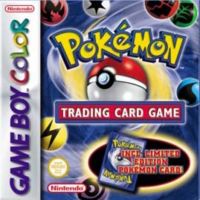Pokémon Trading Card Game

| |
| Pokémon Trading Card Game | |
| Developer | Hudson Soft |
| Publisher | Nintendo |
| System | Game Boy Color, 3DS Virtual Console |
| Release Date | Game Boy Color JP December 18, 1998 US April 10, 2000 EU December 14, 2000 3DS Virtual Console EU/AU July 10/11, 2014 US November 13, 2014 JP December 24, 2014 |
| Rating | ESRB: E |
Pokémon Trading Card Game is a Game Boy game that was based on the popular tie-in 'Pokémon trading card game that Wizards of the Coast released. The game only features cards from the base game, the Jungle expansion, and the Fossil expansion, along with 18 cards that were created specially for the game. The original release of the game also came with a physical promotional card (of Dragonite in Japan and Meowth in other territories).
Story[edit]
A contest has been announced. Anyone who can beat the Grand Masters will win the four Legendary Cards and earn the title of champion. Mark wants to be the champion, but so do many others, including his rival, Ronald.
Gameplay[edit]
The core gameplay involves playing the Pokémon trading card game in matches where each player draws from a deck of 60 cards and follow rules based on those of the real-life game. By winning battles against other opponents, the player can earn booster packs containing more cards that can be used to build different decks. Professor Mason's laboratory contains a machine that can be used to save and build different decks, as well as other machines that can be used to make pre-set custom decks which are unlocked by collecting club medals throughout the game. The game imitates the look of the Game Boy Pokémon games, as it is controlled from a top-down perspective and similar graphics are used for the characters and environments. The player can instantly go to different locations by selecting them from a map, with all locations being accessible from the start of the game.
The game's structure mirrors that of the mainline Pokémon games. There are eight clubs which each specialize in a type of Pokémon and have leaders who must be beaten to earn their club medals, which is similar to the concept of Pokémon Gyms. Collecting all eight medals will allow the player to battle the game's equivalent of the Elite Four, in the form of the four Grand Masters. Just as in the mainline games, there is also an extra opponent to battle after the Grand Masters. The player also has a rival named Ronald who will battle the player at several points in the game. Outside of the main objective, there are also Challenge Cups which are sometimes held at the Challenge Hall. These are tournament battles in which the player must defeat three opponents in a row to earn a promotional card. It is also possible to randomly encounter and battle the bizarre character known as Imakuni?. Additionally, a man named Ishihara can be found in his home, where he will offer promotional Pikachu cards in special trades.
Copies of Pokémon Trading Card Game can be connected through the link cable in separate Game Boys for multiplayer capabilities which allow players can battle or trade cards. If both players possess a Game Boy Color, they can use the infrared port to do a Card Pop, which gives each player a random card. This game also featured connectivity with the Game Boy Printer, which allowed players to print out individual cards, custom deck listings and lists of every card collected in the game.
There were 226 individual cards available within the game, along with two Phantom Cards for a total of 228. However, the Phantom Cards could only be obtained through the Card Pop feature, and oversight with the feature made one of the two (Venusaur) unobtainable.
Legacy[edit]
Some of the cards made for the game were later published in real life. To date, this game and its sequel would stand as the only video games made based on the Pokémon Trading Card Game.
Ports/Remakes[edit]
- In 2014, it was released for download on the 3DS as part of the 3DS Virtual Console. In this version, some of the features are disabled due to the limits of this release and its hardware, including the Card Pop feature, the Game Boy Printer connectivity and the ability to link with other players.
- In August 2023, it was added to the Nintendo Switch's digital library of Game Boy games that could be played by Nintendo Switch Online subscribers. This release retained the multiplayer features, which could now be carried out through wireless local communication or online, and it only lacked the Game Boy Printer functionality.
Sequels[edit]
Its only sequel was Pokémon Card GB2: GRdan Sanjou!, which was only released in Japan.